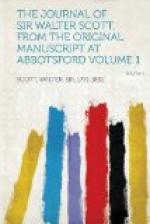On recalling my own recollections during my journey I may note that I found great pleasure in my companion’s conversation, as well as in her mode of managing all her little concerns on the road. I am apt to judge of character by good-humour and alacrity in these petty concerns. I think the inconveniences of a journey seem greater to me than formerly; while, on the other hand, the pleasures it affords are rather less. The ascent of Stainmore seemed duller and longer than usual, and Bowes, which used to strike me as a distinguished feature, seemed an ill-formed mass of rubbish, a great deal lower than I had supposed; yet I have seen it twenty times at least. On the other hand, what I lose in my own personal feelings I gain in those of my companion, who shows an intelligent curiosity and interest in what she sees. I enjoy therefore, reflectively, veluti in speculo, the sort of pleasure to which I am now less accessible.
October 14.—Strolled about in the morning with Morritt, and saw his new walk up the Tees, which he is just concocting. Got a pamphlet he has written on the Catholic Question. In 1806 he had other views on that subject, but “live and learn” as they say. One of his squibs against Fox and Grenville’s Administration concludes—
“Though they sleep with
the devil, yet theirs is the hope,
On the scum of old England,
to rise with the Pope.”
Set off at two, and reached Wetherby to supper and bed.
It was the Corporation of Leeds that by a subscription of L80,000 brought in the anti-Catholic candidate. I remember their subscribing a similar sum to bring in Morritt, if he would have stood.
Saw in Morritt’s possession an original miniature of Milton by Cooper—a valuable thing indeed. The pedigree seemed authentic. It was painted for his favourite daughter—had come into possession of some of the Davenants—was then in the Devonshire collection from which it was stolen. Afterwards purchased by Sir Joshua Reynolds, and at his sale by Morritt or his father.[358] The countenance handsome and dignified, with a strong expression of genius, probably the only portrait of Milton taken from the life excepting the drawing from which Faithorne’s head is done.
[Grantham,] October 15.—Old England is no changeling. It is long since I travelled this road, having come up to town chiefly by sea of late years, but things seem much the same. One race of red-nosed innkeepers are gone, and their widows, eldest sons, or head-waiters exercise hospitality in their room with the same bustle and importance. Other things seem, externally at least, much the same. The land, however, is much better ploughed; straight ridges everywhere adopted in place of the old circumflex of twenty years ago. Three horses, however, or even four, are often seen in a plough yoked one before the other. Ill habits do not go out at once. We slept at Grantham, where we met with Captain William Lockhart and his lady, bound for London like ourselves.




